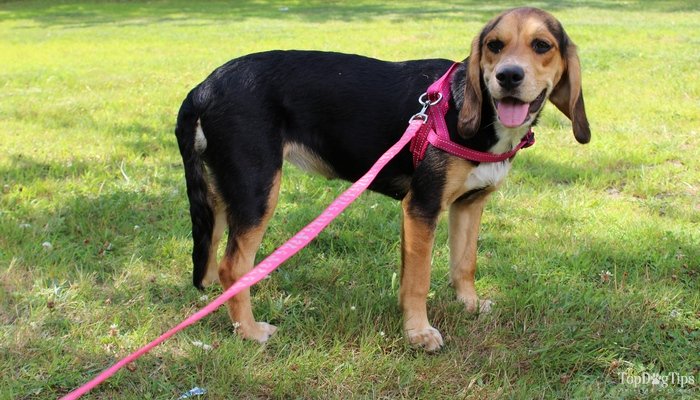How to Train a Dog to Walk on a Leash (Simple Step-by-Step Guide)
All dogs need regular exercise. Some people are lucky enough to have a large yard for their pet to run around in. If you don’t, you’ll have to put your dog on a leash and take him for a stroll. Learning how to train a dog to walk on a leash is imperative to making daily exercise an easy and safe task for both of you.
As with any type of dog training, this will take some patience and time. In my video above, you’ll see that it’s taken us months of leash training to work proper manners with our stubborn little Beagle, Molly.
She’s doing better now than she was, but I found dog leash training to be a time consuming and sometimes frustrating process. Your dog may not be as stubborn as our little Molly, but even the fastest learners won’t grasp walking on a leash overnight.
The process of training a dog to walk on a leash is actually the easy part. It’s putting these skills to use that will be tricky for most owners. You’ll need to stay calm and be patient, follow the exact steps consistently, and if you do, you’ll be walking with your dog on a leash without any problems in no time.
How to Train a Dog to Walk on a Leash
 1. Use an Appropriate Leash and Collar or Harness
1. Use an Appropriate Leash and Collar or Harness
As I explain in my video, I prefer to use a no-pull harness instead of a leash and collar combo for training a dog to walk on a leash safely. While you can certainly use a leash and collar, especially if your dog isn’t a puller, I would still recommend a harness for all dogs that are new to leash walking, simply because they’re safer.
As you start walking the dog, they won’t understand what is going on at first; he may pull on the leash or try to back out of a collar because it’s unusual for them. If your dog’s collar is properly fitted, then this shouldn’t be an issue. Nevertheless, think of the pressure and strain that a pulling dog is going to put on his own neck and throat.
This is why I recommend a harness. A no-pull dog harness spreads the pressure out evenly through your dog’s chest (which is also more resistant to pressure than a throat), causing your pet no harm and eliminating the risk of injury to his throat and thorax. If you’re going to use a collar, pick a no-pull one that’s slightly safer.
2. Fit the Collar or Harness Properly
Whether you choose a collar or a harness, be sure that the device is properly fit on your dog. Collars should fit tightly around your dog’s neck, but not too tightly. You should be able to comfortably slip two fingers between the collar and your pup’s neck.
With the harness, the risks are significantly reduced; however, most pet owners will find it complicated to fit a harness onto their dog the first few times. If you need more help on properly fitting your dog with a harness, watch my guide here.
Once the harness or collar is properly fit an adjusted, allow your dog plenty of time to walk around with it on so your pet gets used to it. Let him get familiar with the feeling of the harness or collar so he will realize that it is comfortable and unobtrusive, and it does not restrict the dog’s range of motion.
After your dog is used to the harness/collar, then allow him some time to get used to the leash, too. Place the leash on the floor where your pet can sniff it. Then, attach it to the harness for 1-2 minutes at a time so he realizes that the leash isn’t a threat. Do this several times before going out for a walk outside.
3. Find a Motivational Reward
As with most dog training methods, you’ll need a reward that motivates your dog. With some dogs, not every average pet treat is going to work, so you’ll need to find the right one.
For example, in the video above, I explain that my Molly isn’t highly motivated by regular biscuit treats. She eats them and seems to enjoy when I use them as a reward for other training, but they don’t motivate her enough to want to walk on a leash (i.e. she’d rather skip the treat than do what’s needed).
As I’ve displayed in the video, generally, Molly refuses to walk on a leash at all; it’s her albatross. We’ve been struggling to train her for leash walking for quite some time, but she’s just not into it. So my solution was to find a highly motivational reward, something that would be a good enough reason for her to want to participate in leash training.
I finally found that reward – turkey.
4. Do Not Pull on the Leash
Some dog owners think that if they just coax their pup along and pull on the leash a little bit, the dog will naturally follow and begin to walk along, as if understanding what you’re trying to accomplish. This is false.
While this “technique” may work with a select number of dogs, it’s not the best way to teach a dog how to walk on a leash, and it could also result in your pooch getting injured and making your training harder in the future.
Moreover, pulling on your dog’s leash may cause your dog to become nervous and view the leash as a threat. It may also backfire and cause the dog to become scared of the leash, which will lead to him trying to back out of his harness and escape.
5. Start with Small Steps and Increase Distance Gradually

As with all dog training, learning how to train a dog to walk on a leash needs to be done gradually. As you’ll see in my video, you want to start down on your dog’s level, about 2 feet in front of him.
Using that motivating treat that you’ve selected, show your pup the snack and call him toward you. If he’s like my Molly, he’ll be a bit skittish at first, but he’ll come get the treat eventually. When the dog does make his way to you, lots of affection and praise will show him that he’s doing what you want. Dogs love please their owners.
Once your pet gets comfortable walking 2-3 feet toward you, you can slowly increase the distance between the two of you until you’re entire leash length away. As you back away from the dog, you’ll also want to decrease the use of the treat, only treating him every other or every third time that he comes to you.
Slowly increase your height, too. You can start on the dog’s level to make him feel more comfortable at first, but as he begins to understand the concept of walking on the leash, stand up a little straighter each time you train him. The goal is to get him used to walking beside you when you are standing up.
When your dog walks comfortably on the leash, you can begin moving around your yard. Again, as with previous methods, you’ll need to build your dog’s stamina gradually here, too. Small dogs and puppies won’t be able to walk as long as larger breeds.
Begin with short walks around the yard or down your street. 5 minute walks are a great starting point and you can keep increasing them in 5 minute intervals once your dog has built up his endurance.
6. Stay Calm, Stay Patient, Stay Consistent
I briefly mentioned that all types of dog training takes patience. If you get frustrated, your dog is going to pick up on it, and he’ll become upset too. If you feel yourself getting angry or frustrated at the dog, take a break and come back to your training later.
Learning how to train a dog to walk on a leash isn’t something that will happen in one session. With most dogs, it won’t even happen in a few sessions. Depending on your pet’s “trainability,” this type of training will take many sessions over the course of many days.
A dog’s personality is a determining factor here. As you can see from my photos above, I have three dogs. My Boxer Chloe and my chocolate Labrador Saddie took to leash walking very quickly without complications. They love it, they don’t mind it, and it only took them a couple of weeks to learn how to properly walk on a lead.
My Beagle Molly, however, was proving to be much more difficult to leash train. When teaching a dog to walk on a leash, you need to keep your dog’s happiness in mind. With any training method, work at your pet’s pace. If your pooch is having fun and enjoying the training, continue; if he’s starting to get discouraged, take a break.
7. Best Harnesses and Collars for Leash Training
For regular walks, once your dog has been leash trained properly, most any dog harness or collar/leash combo will work. However, during the training itself, you need to be more careful about which products you choose to use to prevent injuries, especially if your pet is a puller. Here are some of the best dog harnesses and collars for leash training.
8. My Favorite Dog Training Books for More Tips
This above guide on dog leash training is pretty simple and straightforward; however, if you’re still having trouble with teaching your dog how to walk on a leash without any issues, you might want to read some more detailed guides. Books are a great resource for this, especially those that include photos.
There are many dog training books you can buy, and most of them have useful advice, step-by-step guides and instructions, and tips for most common mistakes owners make. My favorite among straight-to-the-point books is 101 Dog Tricks – it’s simple and doesn’t over-complicate the process, and has tons of cool dog training tricks.

Most of these dog training books are written by famous trainers, so you know you’re in good hands (and no, I do not recommend the Cesar Milan book). All of them contain detailed guides and additional tips, and plenty of photos to illustrate the point the author is making. After you’ve learned how to train a dog basic commands and have that foundation, you can smoothly sail through more advanced training.
READ NEXT: How To Stop A Dog From Pulling










